List of Contents
What is the Green Cardamom Market Size?
The global green cardamom market size is accounted at USD 946.32 million in 2025 and predicted to increase from USD 999.32 million in 2026 to approximately USD 1,545.31 million by 2034, expanding at a CAGR of 5.60% from 2025 to 2034. The growth of the green cardamom market is attributed to the increased global demand for cardamom, expanding food tourism, and heightened interest in exotic flavors and cuisines.
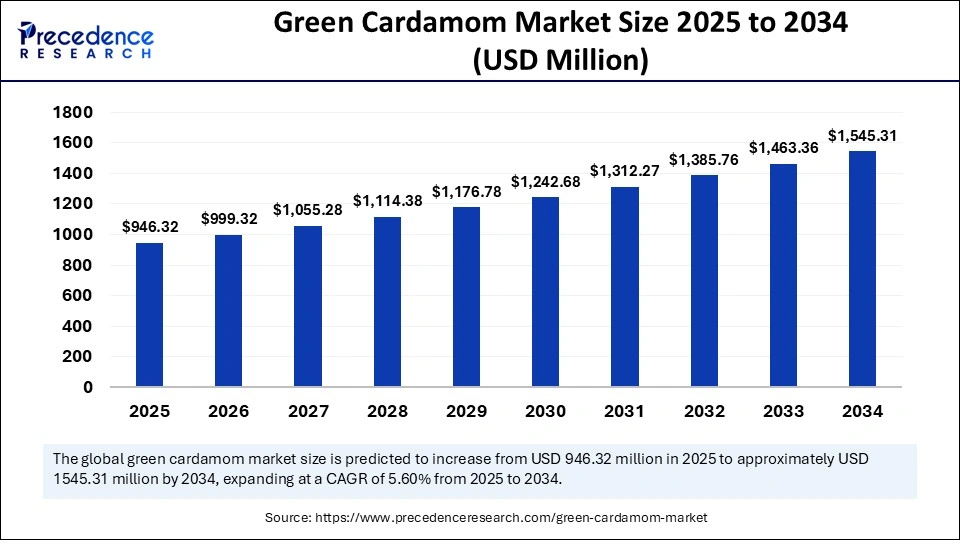
Green Cardamom Market Key Takeaways
- Asia Pacific dominated the market with the largest share of 55% in 2024.
- Europe is anticipated to expand at the fastest CAGR of 6.71% between 2025 and 2034.
- By product, the small segment held the major market share of 62% in 2024.
- By product, the large segment is expected to grow at a CAGR of 6.1% during the forecast period.
- By nature, the conventional segment accounted for the highest market share of 85% in 2024.
- By nature, the organic segment is projected to grow at a CAGR of 7% during the forecast period.
Artificial Intelligence: The Next Growth Catalyst in Green Cardamom
Artificial Intelligence (AI) can be applied in the quality control process of cardamom. AI-powered color sorter machines can be applied for accurate detection and removing discolored or defective cardamom in quality assessment by leveraging advanced algorithms and high-resolution cameras. Non-destructive quality grading techniques, such as e-nose technology for identification of different grades of green cardamom aroma profiles and computer vision for evaluation of visual features like shape and size, can be combined by training machine algorithms such as Bayesian Network (BN), Decision Tree (DT), and System Vector Machine (SVM) for improving accuracy and reliability rather than using either method alone.
Machine learning models can be applied to identify cardamoms and their biological adulterants with high accuracy. AI-powered models can also be applied to identify pests and diseases by analyzing images of cardamom leaves, leading to early intervention and prevention of crop loss.
- For instance, in July 2024, the National Informatics Centre (NIC) signed a Memorandum of Understanding (MoU) with the Spices Board with the aim of deploying AI-based models for the detection and classification of cardamom diseases.
Strategic Overview of the Global Green Cardamom Industry
Green cardamom (Elettaria cardamomum) is an herbaceous, perennial plant of the ginger family and is also known as the “Queen of Spices” due to its unique flavor and strong aroma. This spice is highly valued for its various properties such as anti-inflammatory, antidiabetic, and antioxidant beneficial for health. Green cardamom is native to southern India and is available in international markets in different grades such as Alleppey Green Superior (AGS), Alleppey Green Bold (AGB), and Allepey Green Extra Bold (AGEB).
The growing demand for green cardamom, increased consumer preference toward naturally derived foods with a sensory experience, expansion of retail channels, and availability of efficient supply chains contribute to market growth. In addition, the rising applications of cardamom in the cosmetic industry, the surge in research activities for developing improved varieties, the surge in export rates of green cardamom, and rising disposable incomes are driving the growth of the green cardamom market.
Market Outlook
- Market Growth Overview: The Green Cardamom market is expected to grow significantly between 2025 and 2034, driven by the rising consumer awareness of cardamom's health benefits, the expansion of new applications, and premium and organic products.
- Sustainability Trends: Sustainability trends involve growing demand for organic cardamom, ethical and trade practices, and traceability and transparency.
Major Investors: Major investors in the market include McCormick & Company, Olam International, Givaudan SA, Private Equity Investors, and Cardex S.A. - Startup Economy: The startup economy is focused on e-commerce and direct-to-consumer platforms, value-added products, and sustainable and organic sourcing.
Green Cardamom Market Growth Factors
- Ad campaigns: Manufacturers promote green cardamom products with exotic flavors and nutritional benefits like Vimal Elaichi through celebrity endorsements and star-studded television commercials.
- Ethnic cuisine popularity: Green cardamom is highly featured in Asian and Middle Eastern cuisines. The growing popularity of these cuisines is driving the global demand for green cardamom.
- Rising disposable incomes: With the rise in consumer disposable income, spending on flavoring ingredients is rising. Green cardamom is a popular spice used in various cuisines.
Market Scope
| Report Coverage | Details |
| Market Size by 2034 | USD 1,545.31 Million |
| Market Size in 2025 | USD 946.32 Million |
| Market Size in 2026 | USD 999.32 Million |
| Market Growth Rate from 2025 to 2034 | CAGR of 5.60% |
| Dominated Region | Asia Pacific |
| Fastest Growing Market | Europe |
| Base Year | 2025 |
| Forecast Period | 2025 to 2034 |
| Segments Covered | Product, Nature, and Region |
| Regions Covered | North America, Europe, Asia-Pacific, Latin America and Middle East & Africa |
Market Dynamics
Drivers
Burgeoning Global Demand
The rising demand for green cardamom across the globe is a key factor driving the growth of the green cardamom market. This increase is mainly driven by the rising demand for flavoring ingredients. Green cardamom is a versatile spice used in various cuisines. Rising consumer preference for natural ingredients and organic products due to increased awareness about the health and environmental repercussions associated with synthetic pesticides and fertilizers are driving the demand for natural spices, including green cardamom. Potential therapeutic benefits of green cardamoms like treating respiratory issues and digestive disorders, among others, increased their use in food and beverages. The rising demand for functional foods, as well as expanding applications in pharmaceuticals, are boosting the growth of the market.
Restraint
Changing Climate Conditions
Green cardamom requires an ideal environment for growth. Changing climatic conditions directly impact cultivation, potentially hindering the growth of the green cardamom market. Conditions such as erratic rainfall patterns, rising incidences of pests and diseases, fluctuations in temperature, soil degradation and erosion, growing frequency of extreme weather events, and scarcity of water impact the cultivation of cardamom, particularly for water-intensive varieties. This leads to shifts in agroecological zones, increased price volatility, and supply chain disruptions, causing market instability.
Opportunity
Government Support
Major producing countries of green cardamom are gaining support from their governments, such as attractive schemes, supporting cardamom farmers and cultivation practices. Governments offer financial assistance, initiate e-auctions, and develop price stabilization strategies. Additionally, green cardamom is a valuable spice that significantly contributes to the agricultural GDP, further generating lucrative export revenues and creating opportunities for market growth.
- For instance, in September 2024, the Spices Board India launched an initiative titled "Sustainability in Spice Sector through Progressive, Innovative and Collaborative Interventions for Export Development (SPICED)" to improve the productivity of cardamom and accelerate the export rates.
Product Insights
The small segment dominated the green cardamom market with the largest share in 2024. Small green cardamom is preferred in various culinary applications across many South Asian and Middle Eastern countries. Compared to large cardamom varieties, these cardamoms are preferred for their strong aroma and intense flavor. Small cardamom is considered an important cash crop in major producing regions, like Guatemala and India, assuring continuous production. Ongoing research activities focused on enhancing the varieties, such as high-yielding and disease-resistant varieties, further bolstered segmental growth. Increased use of small cardamoms in beverages, prolonged historical application in traditional medicine like Ayurveda, and increased preference for natural and organic ingredients further solidify the segment's positions.
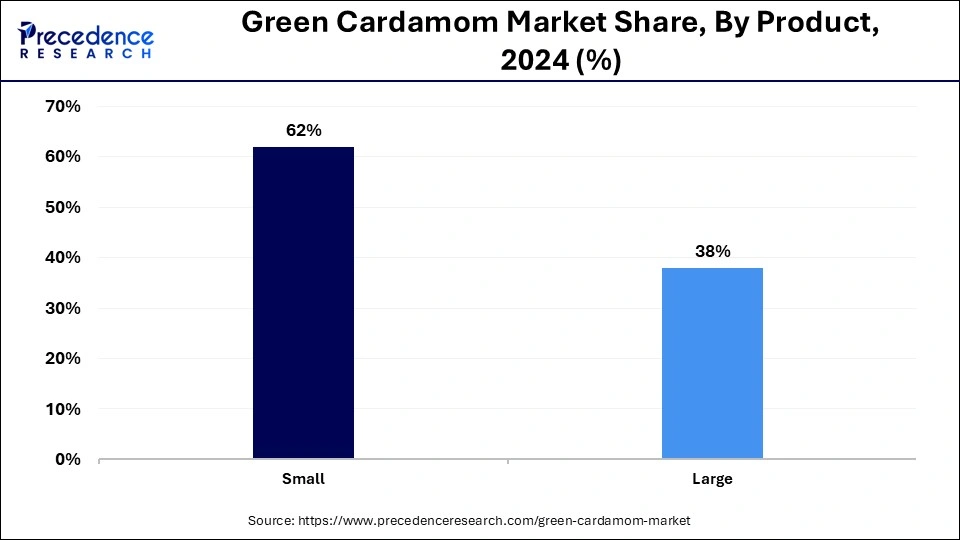
The large segment is expected to grow at the fastest rate during the forecast period. Large cardamoms are widely used in savory dishes and spice blends. Their strong, smoky, and pungent aroma and unique flavor are boosting their demand in the market. Increasing use in home cooking, growing demand in global cuisines, shifting consumer preference for organic and sustainable products, and rising awareness of distinct properties of large variety among consumers and chefs are fostering the segment's growth. Furthermore, the rise in domestic production and distribution is expected to drive the growth of the segment in the upcoming years.
Nature Insights
The conventional segment held the largest share of the green cardamom market in 2024. Conventional farming for green cardamom is a well-established method with a proper infrastructure for ensuring the consistent and stable supply, further reducing costs and making it an affordable option for consumers. The surge in demand from various industries, long-term trade relationships, and widespread distribution networks further bolstered segmental growth. Moreover, increased emphasis on conventional green cardamom cultivation and the development of drought-tolerant varieties, as well as improved propagation and planting techniques, such as clonal propagation, are supporting the long-term growth of the segments.
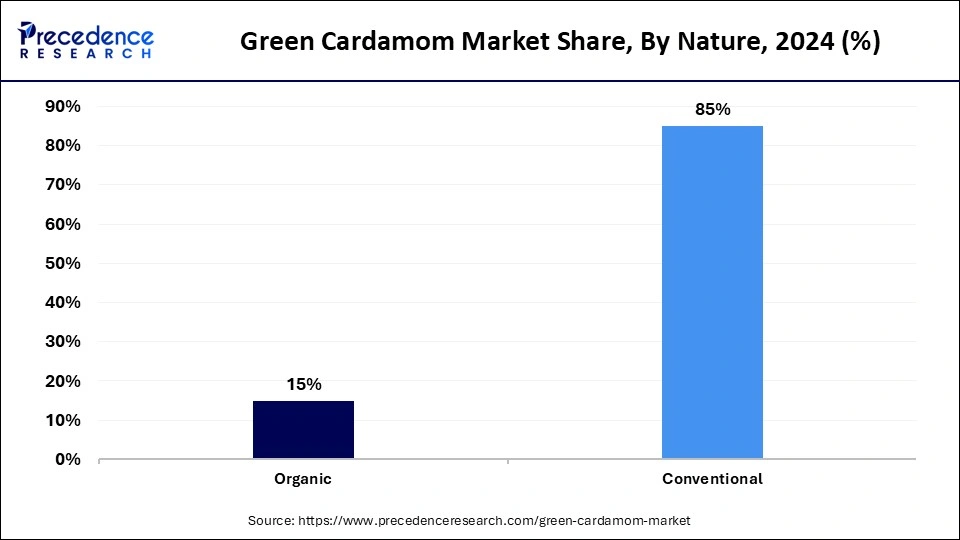
The organic segment is projected to grow at the highest CAGR during the forecast period. Organic green cardamoms have numerous health benefits perceived by their high quality and purity, which are driving their demand among health-conscious consumers seeking natural and chemical-free food ingredients. Moreover, the rising shift toward organic farming practices is likely to support segmental growth. Technological advances are helping boost the production of natural and organic green cardamoms while reducing overall costs.
Regional Insights
Asia Pacific Green Cardamom Market Size and Growth 2025 to 2034
The Asia Pacific green cardamom market size is exhibited at USD 520.48 million in 2025 and is projected to be worth around USD 857.65 million by 2034, growing at a CAGR of 5.69% from 2025 to 2034.
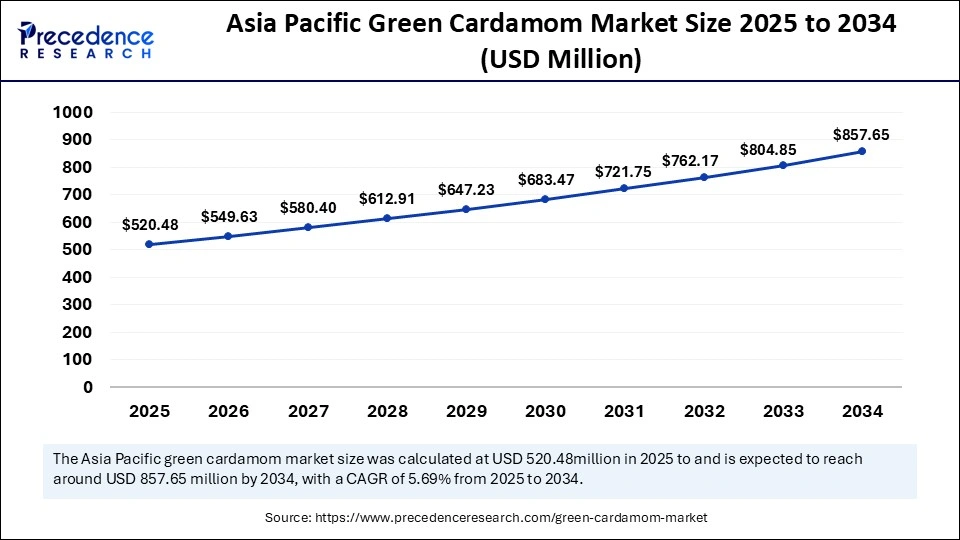
Asia Pacific dominated the global green cardamom market by holding the largest share in 2024. This is mainly due to the high production and consumption rates as well as the presence of key producing countries, including India, Sri Lanka, and Vietnam. Favorable climatic conditions, robust agricultural base, government support, and rising disposable incomes in emerging countries further reinforce regional market growth in the long term. Additionally, green cardamom is a staple in many areas of Southeast Asian countries and is cultivated on a large scale due to its high domestic and international demand.
- For instance, from October 2023 to September 2024, India exported a total of 2,099 shipments of green cardamom.
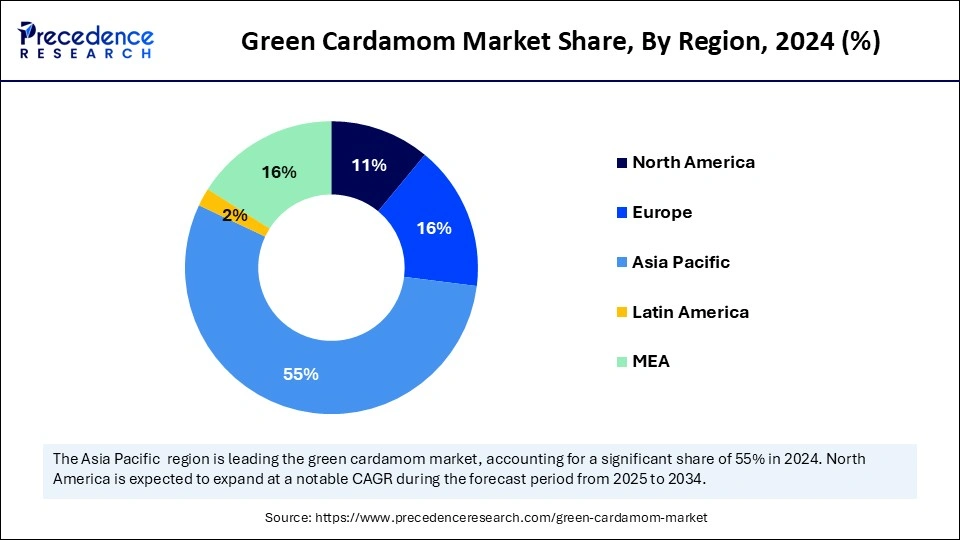
Europe is expected to witness the fastest growth during the forecast period
The region's market growth is driven by the rising demand for naturally derived food ingredients, the increasing popularity of ethnic and global cuisine, and growing applications in various food & beverages. In addition, the surging use of green cardamom in personal care and cosmetic products and the presence of well-established food processing, food service, and retail industries support regional market growth. Germany plays a major role in the European green cardamom market owing to the strong presence of the food and beverage industry. Germany is the key distributor of premium food ingredients and high-value spices, including green cardamom, which drives the growth of the market.
Germany Green Cardamom Market Trends
Germany's green cardamom market is expanding, driven by consumer demand for exotic and organic spices and the popularity of diverse cuisines. The overall German seasoning and spice market is projected to grow significantly. Guatemala dominates as the primary supplier, while demand for organic-certified products remains strong due to Germany's large organic market.
Top Companies in the Green Cardamom Market & Their Offerings
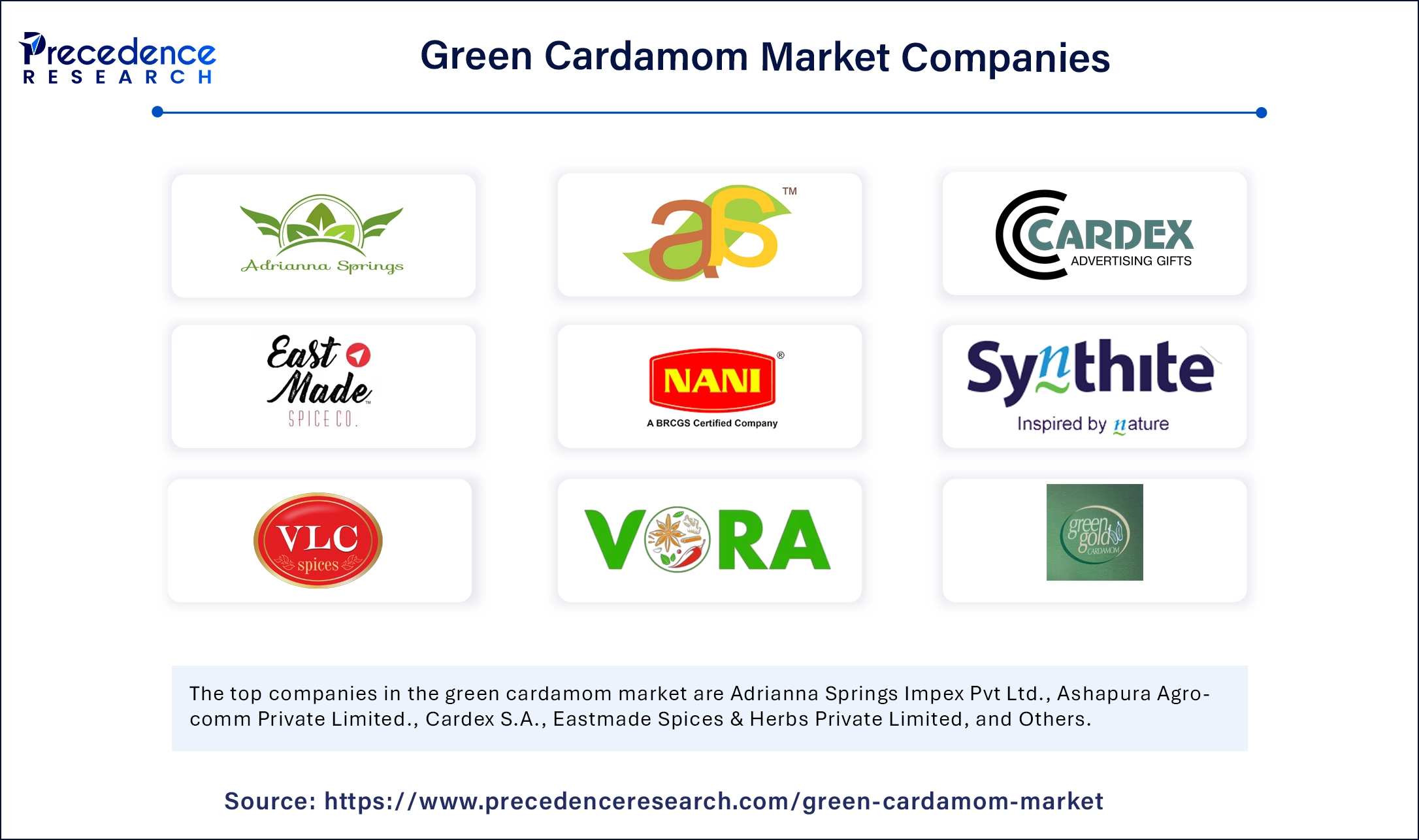
- Adrianna Springs Impex Pvt Ltd contributes to the market as a major Indian exporter, supplying high-quality green cardamom sourced directly from farmers in the Western Ghats region to a global consumer base, including the German market.
- Ashapura Agrocomm Private Limited is an importer and is one of the prominent players in the global green cardamom market, facilitating trade and distribution networks.
- Cardex S.A. is a key player in the green cardamom industry, involved in global trade and distribution channels.
Eastmade Spices & Herbs Private Limited is one of the major players in the green cardamom industry, contributing through supply and trade in the global market. - MAS Enterprises Ltd specializes in cultivating, processing, and exporting spices, particularly green cardamom, and is acknowledged as a top exporter in foreign markets, ensuring a consistent supply of quality product.
- Nani Agro Foods contributes as a major industry player involved in the production and supply of green cardamom products to meet global demand.
- Synthite Industries is a prominent player in the market, likely involved in producing value-added products like cardamom essential oils and oleoresins, which are in demand in markets like Germany.
- Vandanmedu Green Gold Cardamom Producer Company Limited is a producer company that plays a vital role in sourcing and supplying green cardamom from the Vandanmedu region, a primary physical market in Kerala, India, ensuring a steady supply chain.
- VLC Spices contributes as a global food company that produces high-quality products for the global food industry, ensuring safety and efficient delivery of various spice products, including green cardamom.
- Vora Spice Mills LLP is a significant player in the green cardamom market, contributing through its involvement in the processing, supplying, and milling of the spice.
Recent Developments
- In October 2024, Brighton Gin announced the launch of its limited-edition Spice Circuit Gin in collaboration with Brighton-based chef Kanthi Thamma. The Spice Circuit Gin comprises botanicals and spices such as black pepper, curry leaf, green cardamom, and mace.
- In September 2024, the Spices Board India (Ministry of Commerce and Industry, Government of India) launched a mobile application called the CardsApp with the aim of improving cardamom production by providing farmers with evidence-based insights. The app was launched during the Spices Conclave and Buyer-Seller Meet at the Indian Cardamom Research Institute in Myladumpara in Idukki.
Segments Covered in the Report
By Product
- Small
- Large
By Nature
- Organic
- Conventional
By Region
- North America
- Europe
- Asia Pacific
- Latin America
- Middle East & Africa
For inquiries regarding discounts, bulk purchases, or customization requests, please contact us at sales@precedenceresearch.com
Frequently Asked Questions
Ask For Sample
No cookie-cutter, only authentic analysis – take the 1st step to become a Precedence Research client


